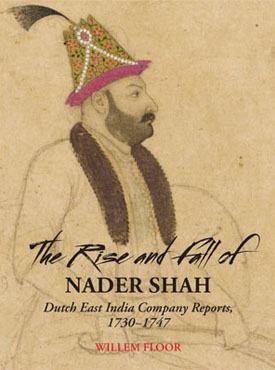About the Book
By any measure, Nader Shah—founder of the Afsharid Dynasty—ranks as a towering figure in Iranian history. Rising from the humblest of origins, he became a military commander of genius, restored an embattled Persia to imperial greatness, and proceeded to wield the power of the throne with a ruthlessness that approached derangement. Yet much about the man and his tumultuous times remains obscure. This book peers into the shadows by drawing on unusual source materials—unpublished letters and reports written by the staff of the Dutch East India Company, who watched in dismay as the tyrant sacrificed the nation’s economic health (and Dutch hopes for trade) to feed his war machine.
The book looks at his entire life: how a shepherd boy mastered fighting skills, assembled armies, reunited Iran and freed it from Afghan occupation, invaded and plundered both India and Ottoman Turkey, and crowned himself Nader Shah of Iran after usurping the Safavid throne in 1736. Because there are no other contemporary reports, published or unpublished, of this length and geographical scope, much of the information offered here is unique. Nader Shah, who not only ruined neighboring countries but also his own, is depicted in all his fury and bloodthirstiness —traits often glossed over by later court chroniclers. At times the Dutch observers are so sickened by his total disregard for the well-being of his country and for human life that they pray to God to release Iran from his hold. Release came in 1747, when he was taken by surprise in his bed and assassinated—but not before first killing two of the attackers.
For the first time in English, The Rise and Fall of Nader Shah makes these primary-source eyewitness reports of an important period in Iranian history available to historians and students alike.
About the Author
Willem Floor studied development economics and non-western sociology, as well as Persian, Arabic and Islamology from 1963-67 at the University of Utrecht (the Netherlands). He received his doctoral degree from the University of Leiden in 1971. Since 1983, Dr. Floor has been employed by the World Bank as an energy specialist. Throughout this time, he has published extensively on the socio-economic history of Iran. His books include: Public Health in Qajar Iran, Agriculture in Qajar Iran, and The History of Theater in Iran, as well as, The Persian Gulf: A Political and Economic History of 5 Port Cities, 1500-1730, its second volume, Persian Gulf: The Rise of the Gulf Arabs, 1747-1792, third volume, The Rise and Fall of Bandar-e Lengeh, the fourth volume, Bandar Abbas: The Natural Gateway of Southeast Iran, and the fifth volume, The Persian Gulf: Links with the Hinterland Bushehr, Borazjan, Kazerun, Banu Ka’b, & Bandar Abbas. He has also published, Travels Through Northern Persia, 1770-1774, Titles and Emoluments in Safavid Iran, and A Social History of Sexual Relations in Iran; Labor and Industry in Iran, 1850-1941; Guilds, Merchants and Ulama in 19th Century Iran; The Rise and Fall of Nader Shah; Games Persians Play. His translations include: Samuel Gottlieb Gmelin’s Travels Through Northern Persia 1770–1774 , and with Hasan Javadi, Abbas Qoli Aqa Bakikhanov’s The Heavenly Rose-Garden: A History of Shirvan & Daghestan; Evliya Chelebi’s Travels in Iran and the Caucasus, 1647 and 1654; A Man of Two Worlds: Pedros Bedik in Iran, 1670–1675, The Persian Gulf: The Hula Arabs of The Shibkuh Coast of Iran, and The Persian Gulf: Dutch-Omani Relations A Commercial & Political History 1651-1806.








